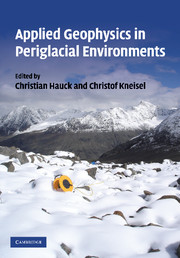Book contents
- Frontmatter
- Contents
- List of contributors
- Introduction
- Part I Geophysical methods
- Part II Case studies
- 5 Typology of vertical electrical soundings for permafrost/ground ice investigation in the forefields of small alpine glaciers
- 6 ERT imaging for frozen ground detection
- 7 Electrical resistivity values of frozen soil from VES and TEM field observations and laboratory experiments
- 8 Results of geophysical surveys on Kasprowy Wierch, the Tatra Mountains, Poland
- 9 Reassessment of DC resistivity in rock glaciers by comparing with P-wave velocity: a case study in the Swiss Alps
- 10 Quantifying the ice content in low-altitude scree slopes using geophysical methods
- 11 The use of GPR in determining talus thickness and talus structure
- 12 GPR soundings of rock glaciers on Svalbard
- 13 Arctic glaciers and ground-penetrating radar. Case study: Stagnation Glacier, Bylot Island, Canada
- 14 Mapping of subglacial topography using GPR for determining subglacial hydraulic conditions
- 15 Snow measurements using GPR: example from Amundsenisen, Svalbard
- 16 Mapping frazil ice conditions in rivers using ground penetrating radar
- Appendix: Tables of geophysical parameters for periglacial environments
- Index
- Plate section
- References
11 - The use of GPR in determining talus thickness and talus structure
Published online by Cambridge University Press: 22 August 2009
- Frontmatter
- Contents
- List of contributors
- Introduction
- Part I Geophysical methods
- Part II Case studies
- 5 Typology of vertical electrical soundings for permafrost/ground ice investigation in the forefields of small alpine glaciers
- 6 ERT imaging for frozen ground detection
- 7 Electrical resistivity values of frozen soil from VES and TEM field observations and laboratory experiments
- 8 Results of geophysical surveys on Kasprowy Wierch, the Tatra Mountains, Poland
- 9 Reassessment of DC resistivity in rock glaciers by comparing with P-wave velocity: a case study in the Swiss Alps
- 10 Quantifying the ice content in low-altitude scree slopes using geophysical methods
- 11 The use of GPR in determining talus thickness and talus structure
- 12 GPR soundings of rock glaciers on Svalbard
- 13 Arctic glaciers and ground-penetrating radar. Case study: Stagnation Glacier, Bylot Island, Canada
- 14 Mapping of subglacial topography using GPR for determining subglacial hydraulic conditions
- 15 Snow measurements using GPR: example from Amundsenisen, Svalbard
- 16 Mapping frazil ice conditions in rivers using ground penetrating radar
- Appendix: Tables of geophysical parameters for periglacial environments
- Index
- Plate section
- References
Summary
Introduction
Talus deposits are widespread in arctic and alpine environments, and represent an important sediment store in these regions. However, detailed information on total thickness and structure of the sediment bodies is sparse. Ground-penetrating radar offers a promising approach to collect data on loose debris quickly and in high resolution. The damping of radar waves is primarily dependent upon the dielectric constant and on the electrical conductivity of the subsurface. Talus deposits are usually very dry and thus very high-resistive (similar to scree slopes, see Chapter 10). Accordingly, the basic preconditions for GPR measurements are very good.
Study sites and data acquisition
The exemplary radargrams presented were measured in the Lechtaler Alps and in the Kühtai area (Austria) from 2003 to 2006 (Figure 11.1). The ‘Parzinn’ is a wide cirque in the Lechtaler Alps at an elevation of 2000–2700 m. Large talus cones have developed under dolostone rockwalls. Most of the cones end downslope at the reverse angle of late-glacial moraine ridges. In numerous radar profiles, a penetration depth of up to 50 m was achieved. The results were validated by additional geoelectric and seismic measurements (Sass2006). The Kühtai area lies in the Central Alps at an elevation of 2300–3000 m, the rockwalls consist of gneiss and mica-schist. Two steep talus cones were investigated by GPR and geoelectric longitudinal and cross profiles. One of the cones ended downslope at a small lake.
For the investigations presented, a RAMAC GPR (MALÅ Geosystems, Sweden) was used.
Information
- Type
- Chapter
- Information
- Applied Geophysics in Periglacial Environments , pp. 165 - 171Publisher: Cambridge University PressPrint publication year: 2008
References
Accessibility standard: Unknown
- 2
- Cited by
